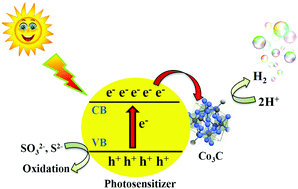Co3C as a promising cocatalyst for superior photocatalytic H2 production based on swift electron transfer processes†
Abstract
Photocatalytic hydrogen production using solar energy has been envisaged as an ultimate energy solution for the future. However, expensive and noble-metal based photocatalysts limit its industrial applications. Herein, highly efficient photocatalytic H2 production has been achieved using Co3C as a noble-metal-free cocatalyst on CdS nanorods (NRs). An enhanced hydrogen evolution rate of 315 μmol h−1 was obtained using the optimized photocatalyst. 420 nm light, an apparent quantum yield of 19% was achieved which is among the best reported carbide-based catalysts. To study the versatile role of Co3C as a cocatalyst, ZnIn2S4 and g-C3N4 nanosheets were employed as photosensitizers. The obtained results successfully demonstrated that Co3C has the ability to play a role as a universal cocatalyst for photocatalytic H2 production. Electrochemical and spectroscopic studies were utilized to propose an appropriate mechanism for the present excellent photocatalytic H2 production. This study showed that Co3C has excessive potential as a promising cocatalyst for inexpensive H2 production.



 Please wait while we load your content...
Please wait while we load your content...